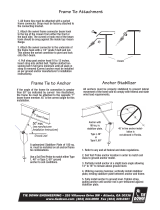
110 Tender/Sport - Owners Manual
Section 6 - Getting to know your Boston Whaler 17
Steering
Trim
Tab
Engine
Lower Unit
Shift only when engine is running. Pause in neutral while
shifting, wait for boat to lose headway, and then shift
quickly. Easing into gear can damage the engine.
CAUTION
!
Gear Shift & Throttle Control
The 110 Sport is equipped with a gear
shift/throttle control unit mounted on
the console directly starboard of the
steering wheel. The gear shift/throttle
control unit for the engine activates
both shifting mechanism and throttle. The control
must be in the NEUTRAL position to start your
engine. Neutral is the most upright position of the
control unit.
Steering pull is unnecessary and unsafe! Steering trim
tabs provided on most engines are frequently improp-
erly adjusted, (they work opposite to normal expec-
tation).
To set steering trim tab for neutral steering:
There is a bolt on the underside center of the tab;
loosen the bolt prior to adjustment.
If boat veers to the right, (hands off), move the aft
end of the tab to the right.
If boat veers to the left, (hands off), move the aft end
of the tab to the left.
The throttle control regulates the RPM of the engine.
Regulating the RPM of the engine will control the
speed of the boat. Pulling back on the gear shift/
throttle control while moving at a high speed will
cause a sudden slowing of the boat and will create a
following wake which may rise above the transom
and flood the boat. Understanding your boat and its
reactions at speed will make boating for you safer
and more enjoyable.
Power Trim Operation
The power trim & tilt system on the 110 Sport al-
lows you to raise and lower the engine outdrive for
trailering, launching and beaching. This also allows
for ideal boat angle (in relation to the water surface)
for a given load and water condition. The power trim
is located on the inboard side of the gear shift/throttle
lever handle. In most cases, best all-round perfor-
mance is obtained with the engine adjusted so that
the boat will run at a 3° to 5° angle to the water.
NOTE: Boats can be operated in a manner and at
certain speeds resulting in trim angles that could
cause visibility to be obscured. Motor trim, hull trim
plane angles (if equipped), boat load distribution
and speed are factors that affect a boats trim angle.
Moving the lever forward engages the forward gear
and then the throttle advance. To reverse power, bring
the control lever back to engage the reverse gear and
increase the reverse thrust.
Gear Shift/
Throttle
Control
1 Forward/Reverse Gear Housing
2 Power Trim Switch (110 Sport 4-Stroke ONLY)
3 Control Handle
4 Throttle ONLY Button
Forward
Neutral
Reverse
2
1
3
4
Steering Pull






















